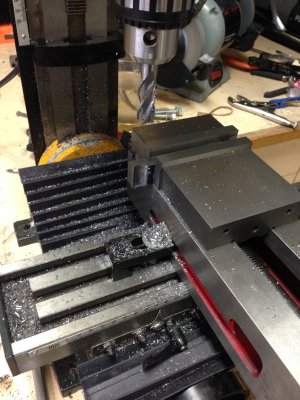I used to use a home made setter-upper jig, same principle of the Cad pic shown. Actually it was a long bar almost the length of the mill table figuring the would give max accuracy. The bar ends had vertical posts contacting the T slot edge. My intention was to start out with a pre-zeroed vise, adjusted the posts to make contact & the jig remains like this. Now with the vise returned to table, you clamp the jig in the exact same manner & secure the vise. It worked pretty good, but it still wasn't 100%. Always +/- 0.001" which you can improve with a DTI. The setup bar needs to be very rigid so now the length works against you vs the smaller jig shown. I think the bigger issue was that vise had side lugs, so when you tightened them down to table, it tended to shift/rotate a bit even with washers. The other style with vertical clamps in a side slot seem better IMO. (plus that vise style can also lay on its side for more utility).
My subsequent 'better' vise purchase has a hardened key & slot(s) in the underside, which is how I think the big boys do it. That similarly engages against the T-slot edge & accomplishes the same thing. If you are lucky it will be very close to zero. Some may even be adjustable. Some guys have machined this into their vise themselves, but do some Googling first. Re dialing-in, the method I've seen often is: snug one side of the vise & leave the other looser. Then as you travers across & bump/adjust, the tighter one acts a bit like a pivot. Otherwise bumping tends to displace the whole vise & takes longer.
The other thing I learned, at least on my mill, is that the inside T-slot edges can have rougher patches from machining and/or filled with remnants of that gooey brown mung (cosmaline?) that ypically coats Asian machines when new to prevent rust . When I got that removed & very lightly stoned the milled edges, it greatly improved repeatability. If you have a nice table with precise & ground edges, I'm jealous. But running a dial across the jaws is the ultimate confirmation setup IMO.

